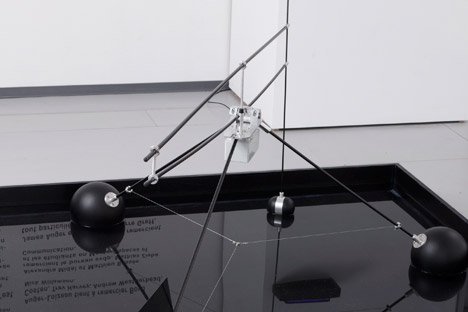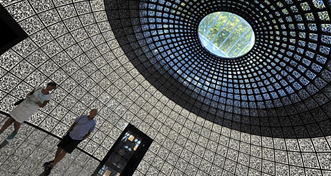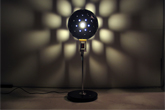Contemporary art and modern science collide in Moscow

The environmental art exhibition “eCONSCIOUSNESS” is part of the ambitious SCIENCE ART program directed by the Moscow Lomonosov State University and the Central House of Artists. Source: Press Photo
The Moscow Biennale of Contemporary Art will host an installation by the art group Recycle, and the shows “Positive / Negative” and “Videonale.14 on Tour” will be presented. In addition, under a joint project of the Scientific Art of CHA and Moscow State University, the exhibition “eCONSCIOUSNESS” will showcase the latest science-art research projects, which explore the intersection of science and the environment.
In their works, artists actualize the issues of social and environmental responsibility, demonstrating the full range of environmental issues—from the interaction of living organisms and their communities to each other, to their interaction with the environment.
At the science-art exhibition, the "Cockroach Controlled Mobile Robot" by Garnet Hertz from the United States and "Decon" by Marta de Menezes from Portugal can be viewed.
"Cockroach Controlled Mobile Robot". Source: Vimeo
"Decon," created by the artist in 2007, is a reproduction of the work of Piet Mondrian; it is a "living" picture that self-destructs in the exposure process. The picture is produced using materials and techniques of biotechnology: A bacterial plant substance is added to certain pigments and paints the environment in the desired color; then, the paint is destroyed by the same bacteria, Pseudomonas Putida.
"Cockroach Controlled Mobile Robot" is a series of artistic and experimental setups that feature a large Madagascan cockroach driving a motor vehicle with a device made of a Ping-Pong ball. Standing on the ball, the cockroach rotates the ball with its legs and moves the vehicle.
The exhibition's curator, Semen Yerokhin, believes that “eCONSCIOUSNESS” will be interesting for a wide audience—from schoolchildren to professional artists and scientists.
“Though in the classical sense we understand ecology as the relationship and interaction between the different species and their habitats, for many of the exhibited works, the term bio-art environmental is more appropriate. It should be considered a special case of scientific art, when, for creating artistic and scientific works, artists use biotechnology based on innovative achievements of genetics, genomics, proteomics and other advanced areas of biology,” Yerokhin said. “Perhaps the biological arts will be the one direction to define the basic trend of the development of modern art in the next century.”
View the video by RBTH: Science and art in unison at the Frontier exhibition in Moscow
The program is designed so that interesting events will be held each day. The most informative day will be Sept.18, when the conference and the opening of the exhibition will be held. The conference, titled "The aesthetic and ethical aspects of synthetic biology technologies in contemporary art," will open at 11 a.m. and will be attended by leading Russian and foreign experts—philosophers, art historians, natural scientists, and artists using technology in the practice of synthetic biology.
Among the foreign artists expected are Garnet Hertz and Marta de Menezes, James Auger and Jimmy Loizeau from the U.K., and Juan Castro from Japan.
A work by James Auger and Jimmy Loizeau, “Carnivorous domestic entertainment robots,” contains devices that combine the functions of disinfestation with the function of an alternative source of electricity. At first glance, it is the usual fixtures (which house an ultraviolet "decoy" and a microbial fuel cell) in which a colony of bacteria decomposes the remains of insects flying into the light, using them to generate electricity to keep the lamp working.
On Sept. 18 at 7 p.m., a master class by the artist and biologist Juan M. Castro from Japan will be held, entitled “On cholesterol, neurons and the emergence of artificial cells.” Castro works at the intersection of media art, microbiology and biochemistry, in projects related to the visualization of biological processes in real time. He was born in Bogotá, Colombia, but he currently lives and works in Tokyo. In 2008, he founded the association Biodynamic Geometries in Tokyo, specializing in experimental scientific and artistic studies of organic life. His interactive installation at “eCONSCIOUSNESS” is called “Impulse.”
Castro already visited Moscow in April 2012, when he showed his work "Heliotropika." So far, he has created five installations. The installation he is coming with this time around is named "Fat between two worlds."
“As materials, fats offer us new understandings about organic matter,” says Castro. “We can use their principles and create new forms of architecture and design based on self-assembly and molecular interactions.” Castro believes that an international event like Science Art in Russia is significant for several reasons. “First, this exhibition wants to cover a relatively new interdisciplinary field that has not yet been coherently described and analyzed.”
Castro also believes that this exhibition will develop new conceptual and practical instruments for the future interactions between aesthetics and life sciences. The exhibition will provide thick descriptions of how emerging biotechnologies, as new material for creation, are managed in relation to art and design principles. In addition, according to the artist, this exhibition will explain how biological art practices can help Russia to confront issues regarding the role of life sciences and the role of new aesthetics in society.
For kids, there will be a children’s program organized by Master of Art Design and led by Nikolai Selivanov. The program will be based on the creative topic “Animals of the Future” and oriented toward the development of creative thinking about ecological problems.
The exhibition will present “Nasekosm" (a puzzle created by children 6-8 years old), "Fish that lived among the people" (the collective work of children 8-11 years old) and "Skin" (the design ideas of children 10-12 years old).
The exhibition’s purpose is to draw public attention to the problems of environmental protection and the development of environmental awareness in the community through the arts, as well as the formation of new methods in the interaction of living organisms and their communities with each other and with the environment.
Unfortunately, projects by Russian artists will not on display. According to Yerokhin, this shows once again that, in Russia, the process of forming of an interdisciplinary platform of scientific art is far behind the global trend.
All rights reserved by Rossiyskaya Gazeta.
Subscribe
to our newsletter!
Get the week's best stories straight to your inbox

